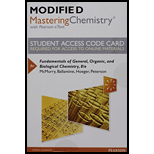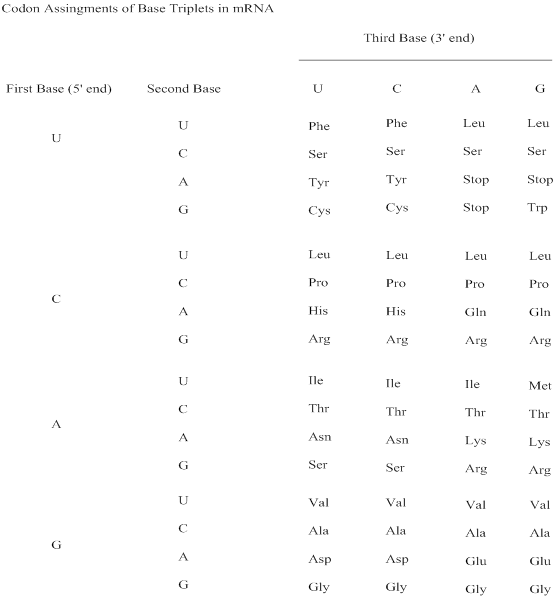
Concept explainers
a)
Interpretation:
The possible codon sequence for Val amino acid has to be predicted.
Concept Introduction:
RNA synthesis: The process of RNA synthesis is Transcription. A small section of DNA unwinds, only one of the two strands act as template and the other strand as informational strand. The complementary bases are attached one by one by the action of RNA polymerase at template strand on moving down. The newly generated RNA is the exact copy of the informational strand, with the exception that a U replaces each T in the template DNA. The RNA synthesised carries genetic information and directs protein synthesis.
Codon: A sequence of three ribonucleotides in the mRNA chain that codes for a specific amino acid; also a three-
Genetic code: The sequence of nucleotides, coded in triplets (codons) in mRNA that determines the sequence of amino acids in protein synthesis.

Illustrated relationships are:
DNA informational strand: 5’ ATG CCA GTA GGC CAC TTG TCA 3’
DNA Template strand: 3’ TAC GGT CAT CCG GTG AAC AGT 5’
mRNA: 5’ AUG CCA GUA GGC CAC UUG UCA 3’
protein: Met Pro Val Gly His Leu Ser
Notice: 5’ end of the mRNA strand codes for the N-terminal amino acid, whereas the 3’ end of the mRNA strand codes for the C-terminal amino acid. Proteins are always written N-terminal to C-terminal, reading left to right.
b)
Interpretation:
The possible codon sequence for ‘Arg’ amino acid has to be predicted.
Concept Introduction:
RNA synthesis: The process of RNA synthesis is Transcription. A small section of DNA unwinds, only one of the two strands act as template and the other strand as informational strand. The complementary bases are attached one by one by the action of RNA polymerase at template strand on moving down. The newly generated RNA is the exact copy of the informational strand, with the exception that a U replaces each T in the template DNA. The RNA synthesised carries genetic information and directs protein synthesis.
Codon: A sequence of three ribonucleotides in the mRNA chain that codes for a specific amino acid; also a three-nucleotide sequence that is a stop codon and stops translation.
Genetic code: The sequence of nucleotides, coded in triplets (codons) in mRNA that determines the sequence of amino acids in protein synthesis.

Illustrated relationships are:
DNA informational strand: 5’ ATG CCA GTA GGC CAC TTG TCA 3’
DNA Template strand: 3’ TAC GGT CAT CCG GTG AAC AGT 5’
mRNA: 5’ AUG CCA GUA GGC CAC UUG UCA 3’
protein: Met Pro Val Gly His Leu Ser
Notice: 5’ end of the mRNA strand codes for the N-terminal amino acid, whereas the 3’ end of the mRNA strand codes for the C-terminal amino acid. Proteins are always written N-terminal to C-terminal, reading left to right.
c)
Interpretation:
The possible codon sequence for ‘Ser’ amino acid has to be predicted.
Concept Introduction:
RNA synthesis: The process of RNA synthesis is Transcription. A small section of DNA unwinds, only one of the two strands act as template and the other strand as informational strand. The complementary bases are attached one by one by the action of RNA polymerase at template strand on moving down. The newly generated RNA is the exact copy of the informational strand, with the exception that a U replaces each T in the template DNA. The RNA synthesised carries genetic information and directs protein synthesis.
Codon: A sequence of three ribonucleotides in the mRNA chain that codes for a specific amino acid; also a three-nucleotide sequence that is a stop codon and stops translation.
Genetic code: The sequence of nucleotides, coded in triplets (codons) in mRNA that determines the sequence of amino acids in protein synthesis.

Illustrated relationships are:
DNA informational strand: 5’ ATG CCA GTA GGC CAC TTG TCA 3’
DNA Template strand: 3’ TAC GGT CAT CCG GTG AAC AGT 5’
mRNA: 5’ AUG CCA GUA GGC CAC UUG UCA 3’
protein: Met Pro Val Gly His Leu Ser
Notice: 5’ end of the mRNA strand codes for the N-terminal amino acid, whereas the 3’ end of the mRNA strand codes for the C-terminal amino acid. Proteins are always written N-terminal to C-terminal, reading left to right.
Want to see the full answer?
Check out a sample textbook solution
Chapter 26 Solutions
Modified Mastering Chemistry With Pearson Etext -- Standalone Access Card -- For Fundamentals Of General, Organic, And Biological Chemistry (8th Edition)
- Which amino acid(s) have the most codons? Which amino acid(s) have the fewest codons? Can you think of a reason why multiple codons code for certain amino acids but other amino acids are coded for by very few codons?arrow_forwardHow would a substitution mutation in the third nucleotide position of the codons for alanine and valine affect the resulting protein?arrow_forwardIs it reasonable that codons for the same amino acid have one or two nucleotides in common? Why or why not?arrow_forward
- The amino acid glycine is encoded by four codons: GGA, GGC, GGG, and GGU. Which of the following statements correctly explains this fact? The glycine anticodon contains the sequence CC, but the 5' base of the anticodon can pair nonspecifically with the 3' base of the codon. The glycine anticodon contains the sequence CC, but the 3' base of the anticodon can pair nonspecifically with the 5' base of the codon. Glycine tRNA has four anticodons, and the appropriate anticodon specifically pairs with the correct codon. There are four tRNAs for glycine, each of which has an anticodon that specifically pairs with the correct codon. all of the abovearrow_forwardName the three non-sense codons?arrow_forwardHow can the 4 nucleotides present in DNA code for the 20 different amino acids found in proteins? How many bases would be needed in a codon if there were five RNA bases instead of four?arrow_forward
- If you have 960 nucleotides, how many codons do you have?arrow_forwardThe template strand of a double helical segment of DNA consists of the following sequence: 5’-GTAGCCTTAAGCGATCACCGTCCGTATTACTAGTGGCCAGACTCTTTTCACTCTCATGTATAGTTG-3’ What will be the overall anti-codon sequence in tRNA?arrow_forwardThe genetic code uses three bases to encode one amino acid. Why can't the code use only two bases to encode each amino acid?arrow_forward
 Biology Today and Tomorrow without Physiology (Mi...BiologyISBN:9781305117396Author:Cecie Starr, Christine Evers, Lisa StarrPublisher:Cengage Learning
Biology Today and Tomorrow without Physiology (Mi...BiologyISBN:9781305117396Author:Cecie Starr, Christine Evers, Lisa StarrPublisher:Cengage Learning Human Heredity: Principles and Issues (MindTap Co...BiologyISBN:9781305251052Author:Michael CummingsPublisher:Cengage Learning
Human Heredity: Principles and Issues (MindTap Co...BiologyISBN:9781305251052Author:Michael CummingsPublisher:Cengage Learning

